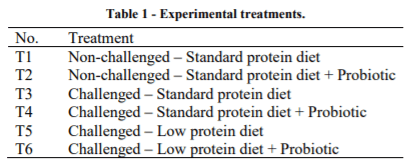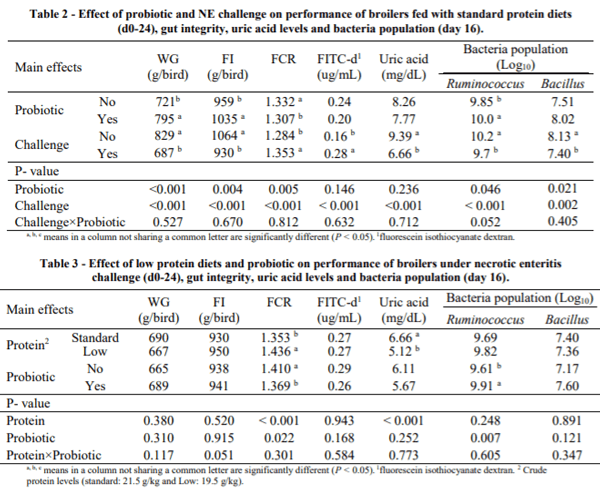I. INTRODUCTION
The withdrawal of antibiotics has caused an increased prevalence of necrotic enteritis (NE) in broiler chickens, making it the most common disease in the poultry-industry globally. Direct fed microbials (DFMs) have been shown to have great potential as alternatives to antibiotic growth promoters (AGPs). Bacillus amyloliquefaciens produces several extracellular enzymes including cellulase, hemicellulose, amylase, xylanase and proteases. Its application has been reported to enhance digestibility and absorption of nutrients and to improve immune function of the gut (Lee et al., 2008). The objective of this study was to determine to what extent Bacillus amyloliquefaciens is able to ameliorate the negative effect of subclinical NE in chickens fed low or standard protein diets.
II. METHOD
A total of 720 d-old Ross 308 chicks (as hatched) were randomly allocated to six treatments, with eight replicates pens per treatment, each with 15 birds. Treatment groups were as listed:

Treatments were analysed in two 2 × 2 factorial arrangements to observe the different main effects. The first comparison was subclinical NE challenge (yes or no) and supplementation of probiotic (yes or no) (T1, T2, T3 and T4). The second analysis compared two different crude protein levels (standard (21.5 g/kg) or low (19.5 g/kg)) and supplementation of probiotic (yes or no) all under subclinical NE challenge (T3, T4, T5 and T6). Dietary concentration of probiotic was 1 x 106 CFU of Bacillus amyloliquefaciens CECT 5940 per g of feed. The experimental diets were fed ad libitum for the duration of the trial period, and were fed as starter (d 0-10), and grower (d 11-24). On d 9, birds in the challenged groups were subjected to an oral gavage of 1 ml Eimeria strains. Non-challenged group were inoculated with 1 ml of PBS. On days 14 and 15, birds were inoculated with approximately 108 CFU of Clostridium perfringens NE18 strain, control birds were inoculated with 1mL of sterile thioglycollate broth. All birds and feed were weighed on d 0, 10 and 24. Average body weight gain (WG), average feed intake (FI) and feed conversion ratio (FCR) were calculated taking mortality into account. On d 16, birds were inoculated with 1 ml dilution of FITC-d (4.17 mg/kg body weight) and serum samples were obtained at 2.5 hours post-inoculation, for gut permeability and uric acid analysis. Serum FITC-d was measured by using a microplate reader (Synergy HT, Multi-mode microplate reader, BioTek Instruments, Inc., VT, USA). Caecal digesta samples were also collected on d 16, for bacterial quantification by quantitative PCR (Shannon et al., 2007).
III. RESULTS
Treatment had a significant impact on broiler performance from d 0-24. According to the results presented in Table 2, NE challenge significantly reduced WG and FI and resulted in higher FCR (P < 0.001). On the other hand, probiotic significantly improved WG (P < 0.001), FI (P < 0.004) and FCR (P < 0.001) in birds. Serum samples of the challenged birds had lower uric acid concentration (P < 0.001) and higher FITC-d content (P < 0.001) compared to the unchallenged birds. Furthermore, analysis of the caecal bacterial population showed that NE challenge decreased the number of Ruminococcus (P < 0.001) and Bacillus (P < 0.01). However, probiotic addition significantly increased Bacillus and Ruminococcus population (P < 0.05).
Regarding the results in Table 3, birds fed low protein diets had a higher FCR compared to those fed standard protein (P < 0.001) and the addition of the probiotic improved the FCR (P < 0.05). Low protein diet groups had less uric acid present in the serum (P < 0.001) compared to those fed the standard protein diet. Also, Ruminococcus population in birds fed low protein diets increased (P <0.01) by probiotic supplementation.
IV. DISCUSSION
Disturbances in broiler intestinal microbial population can result in increased levels of pathogenic organisms and this has consistently been found to negatively impact FI, WG and FCR (Remus, et al., 2014). Probiotics have been shown to improve the development and maintenance of a stable gut microbiome in poultry, which leads to reduced enteric disease and improved growth performance (Ducatelle, et al., 2015). Bacillus amyloliquefaciens is known to produce enzymes that may contribute for improved digestibility of nutrients (Gangadharan et al., 2008). Therefore, the beneficial effects of the probiotic on broiler performance observed in this study could be attributable to better gut health resulting in better utilisation of nutrients. On the other hand, feeding high protein diets has a negative impact on gut health of birds as a result of increased flow of indigestible protein to the large intestine thus increasing metabolite production (Apajalahti and Vienola, 2016). Serum responses provide some evidence of nonessential nitrogen utilisation by the chicks. Lower uric acid observed in birds fed with low protein diets indicates lower nitrogen excretion compounds. A numerical reduction of uric acid concentration in serum of birds fed the probiotic could also be related to better utilisation of protein and amino acid for synthesis rather than metabolism, as uric acid is the major end product of protein metabolism in birds. This could also be a reason for improved performance in probiotic fed groups. Probiotics also help to stabilise the intestinal ecosystem and enhance the growth of beneficial bacteria. Bacillus and Ruminococcus are favourable groups of bacteria that were increased by probiotic supplementation. Production of secondary metabolites and quorum quenching activity by B. amyloliquefaciens, could have supressing effects on the pathogenic bacteria (Doranalli et al., 2017) creating a better growth environment for the beneficial groups. This is reflected in the slight improvement of gut integrity in probiotic supplemented treatments. The positive result could be due to a better gut enviroment and less inflammation and damage to the epithelium cells creating a stronger tight junction in the epithelium. This study concludes that the supplementation of Bacillus amyloliquefaciens in diets can help achieve optimal performance through the modulation of gut health and gut bacteria in broilers under subclinical NE challenge, and improve feed efficiency in broilers fed low protein diets.
ACKNOWLEDGMENTS: We acknowledge Evonik© for funding this project, Bioproperties for providing Eimeria, and Prof. Robert Moore for providing Clostridium perfringens EHE18 strain.
Abstract presented at the 30th Annual Australian Poultry Science Symposium 2019. For information on the next edition, check out http://www.apss2022.com.au/. 







.jpg&w=3840&q=75)